#saliha sultan daughter of abdulhamid i
Photo


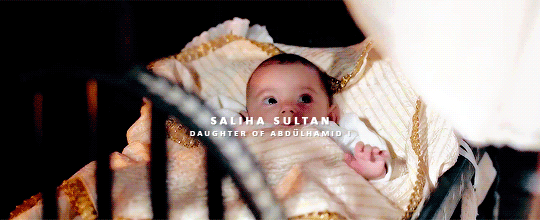

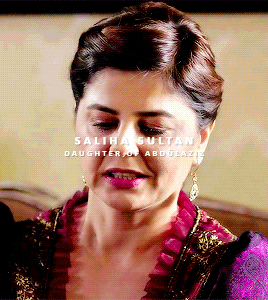
Ottoman Princesses named: Saliha
Saliha is a name of Arabic which means virtuous, pious or devoted to God.
#history#historyedit#ottoman history#ayse humasah hanimsultan#saliha sultan daughter of ahmed iii#saliha sultan daughter of abdulhamid i#saliha sultan daughter of mahmud ii#saliha sultan daughter of abdulaziz#ottomanladiesedit#princessesnames
169 notes
·
View notes
Photo

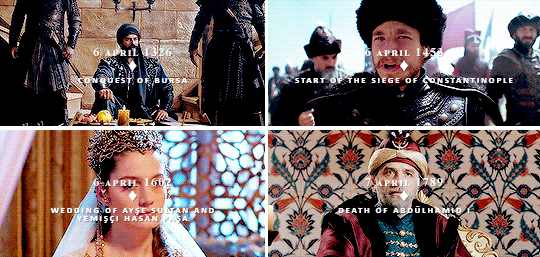

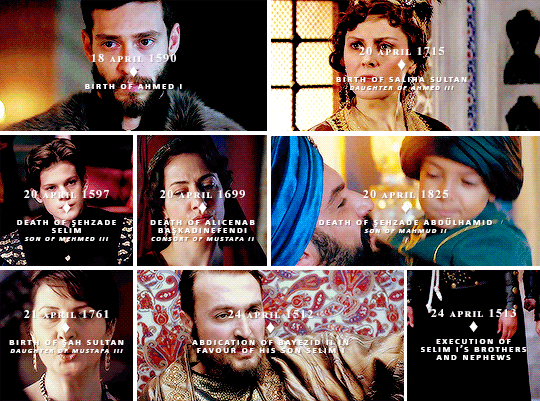
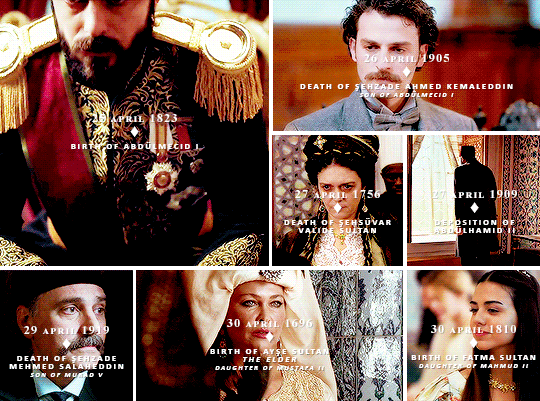
𝐈𝐧 𝐭𝐡𝐞 𝐦𝐨𝐧𝐭𝐡 𝐨𝐟 𝐀𝐩𝐫𝐢𝐥 𝐢𝐧 𝐎𝐭𝐭𝐨𝐦𝐚𝐧 𝐡𝐢𝐬𝐭𝐨𝐫𝐲
#history#historyedit#ottoman history#ayse sultan daughter of murad iii#haseki hurrem sultan#nazikeda kadin#emetullah sultan daughter of mustafa ii#saliha sultan daughter of ahmed iii#alicenab kadin#sah sultan daughter of mustafa iii#sehsuvar sultan#ayse sultan daughter of mustafa ii#fatma sultan daughter of mahmud ii#ottomanladiesedit#*everymonth#abdulhamid i#abdulhamid ii#murad iv#selim i#abdulmecid i
164 notes
·
View notes
Photo






The granddaughters of Sultan Ahmed III of the Ottoman empire who reached adulthood -- requested by anon
#history#historyedit#ottoman history#ahmed iii#saliha sultan daughter of ahmed iii#ayse sultan daughter of ahmed iii#esma sultan daughter of ahmed iii#sah sultan daughter of mustafa iii#beyhan sultan daughter of mustafa iii#hatice sultan daughter of mustafa iii#ayse durrusehvar hanim daughter of abdulhamid i#esma sultan daughter of abdulhamid i#hibetullah sultan daughter of abdulhamid i#ottomanladiesedit
118 notes
·
View notes
Photo







𝐢𝐧 𝐭𝐡𝐞 𝐦𝐨𝐧𝐭𝐡 𝐨𝐟 𝐅𝐞𝐛𝐫𝐮𝐚𝐫𝐲 𝐢𝐧 𝐎𝐭𝐭𝐨𝐦𝐚𝐧 𝐡𝐢𝐬𝐭𝐨𝐫𝐲
#history#historyedit#ottoman history#ottomanladiesedit#*everymonth#husnusah kadin#mehmed vi#murad ii#mahidevran hatun#fatma neslisah sultan daughter of sehzade omer faruk#saliha naciye hanim#saliha sultan daughter of mahmud ii#pertevniyal sultan#mustafa ii#bedrifelek kadin#osman ii#refia sultan daughter of abdulmecid i#murad iv#abdulhamid ii#ummugulsum sultan daughter of ahmed iii#sayeste hanim#adile sultan daughter of mahmud ii#nazima sultan daughter of abdulaziz#abdulaziz#elaru mevhibe kadin#sehzade cem son of mehmed ii#ahmed ii#cemile sultan daughter of abdulmecid i#meleki kalfa
136 notes
·
View notes
Photo





𝐢𝐧 𝐭𝐡𝐞 𝐦𝐨𝐧𝐭𝐡 𝐨𝐟 𝐉𝐚𝐧𝐮𝐚𝐫𝐲 𝐢𝐧 𝐎𝐭𝐭𝐨𝐦𝐚𝐧 𝐡𝐢𝐬𝐭𝐨𝐫𝐲
#history#historyedit#ottoman history#*everymonth#ottomanladiesedit#mihrimah sultan#safiye sultan#mehmed iv#bidar kadin#saliha dilasub sultan#sayan kadin#bedrifelek kadin#refia sultan daughter of abdulmecid i#osman iii#sehzade mehmed son of ahmed i#haseki rabia sultan#murad iii#mustafa i#zekiye sultan daughter of abdulhamid ii#fatma ulviye sultan daughter of mehmed vi#durrusehvar sultan daughter of abdulmecid ii#mustafa iii
143 notes
·
View notes
Note
I have a lot of interest rest in Ottomans. How fashion changed after 1860s in Ottoman women? Ottoman fashion which is shown in Payitaht Abdulhamid in 1890s, was it real? Please explain with pictures
I am sorry for the long wait, I had internet connection problems.
After 1860s is a very specific time but I'll do my best. We can't forget that talking about fashion in a setting like the Ottoman empire is way more difficult because women weren't supposed to be portrayed or photographed so the material is scarce.
It was after the visit of the Empress Eugénie that the women of the palace and the wives of the high functionaries copied as nearly as they could the appearance of the beautiful Empress. They divided their hair in the middle, and spent hours in making little bunches of curls. High-heeled shoes replaced the coloured babouches [slippers]; they even adopted the hideous crinolines and abandoned forever those charming Oriental garments, the chalvar and the entari which they considered symbols of servitude, but which no other fashion has been able to equal in beauty — Zeynoub Hanoum, A Turkish Woman’s European Impressions
The chalvar, called şalvar in Turkish are the characteristic baggy pants that women (and men too) would wear underneath their several layers of clothing. The entari was worn over the undergarments and the şalvar:

These are all XIX century entari.
In any case, rich women began to abandon these clothes for more European ones especially after the visit of Empress Eugénie in Istanbul. This can be seen clearly in children's fashion:

Nazima Sultan in 1876 and Naime Sultan in 1882
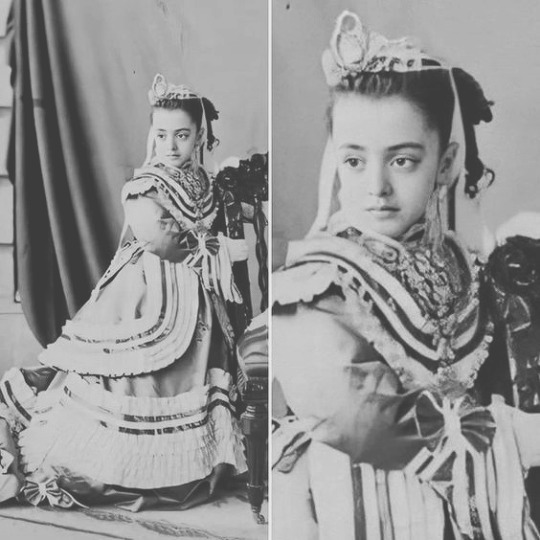
Saliha Sultan in the 1870s
In this period [1867], the young ladies and young girls had completely abandoned the old dresses with three tails or trains and the baggy pants underneath; fashion now demanded shirts with a single train which was caught up and attached to the belt – there were now petticoats instead of şalvars or the baggy pants previously worn. The headdresses had also changed with the times and now usually matched the costumes; there were earrings with jewels, medallions and elaborate hairstyles, garnished with precious stones. — Leyla (Saz) Hanımefendi, The Imperial Harem of the Sultans. Daily Life at the Çıragan Palace During the Nineteenth Century
As for outerwear:
Women changed the thicker cloth they had traditionally used for their feraces (long flowing outer garments) for a much thinner material. They changed their yellow boots of morocco leather for shoes with trimmings of imitation gold thread, which they wore with thin, white socks. They began to use thinner veils and they turned covering themselves into a method for making themselves more alluring, a trend appreciated by Ali Rıza Bey, who commented that ‘the veils of our women, which were a means of ornamenting the face rather than concealing it, became finer. How charming the colourful feraces looked! And these finer veils were unable to obscure the beauty [behind]’. — Ebru Boyar, Kate Fleet - A Social History of Ottoman Istanbul
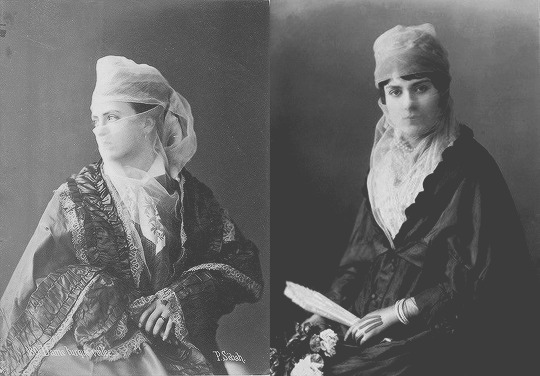
These photographs are great examples of just how fine veils had become. They basically did not hide any feature and this was a problem for conservatives (and sultans as well):
The çarşafs had become merely ordinary dresses, the feraces had turned into sleeveless capes, the veils had become too thin. [Abdülhamid II] issued an order that this should not occur. Further, women were not to wear coats or short, tight-waisted jackets which imitated military styles — Ebru Boyar, Kate Fleet - A Social History of Ottoman Istanbul

In the photograph above you can see a western dress underneath the ferace and several rows of what seem to be pearls.
In the XIX century, women (especially wealthy women of course) began to go out more, especially to pleasure gardens or at the Bosphorus shore. This meant that new accessories began to be used, among them the parasol. As pleasure gardens (ie. parks) were public places, men and women could see each other in these occasions:
A parasol in the rowing boat! It explains what the person wants to say. For example, if it is bent a little to one side, it means ‘I am annoyed with you’, if it is bent over further, ‘I am really angry’, if it completely covers the face, it means ‘you will not see my face again’, ‘I don’t want to see you, have you still not understood?’, if it swings hard from right to left, it signifies ‘don’t stay, pass by’, ‘return, go’, if it falls slightly to the front, it is in the place of a greeting, ‘welcome, sir’, if it falls a lot, ‘my heart has beaten again’, if it goes to the back, it means ‘oh!’, if it leans all the way over backwards, ‘what a state I am in, see me and have pity!’, if it is held to the side, ‘oh, how fine, what happiness this is!’, if it is opened and closed, it means ‘not tonight, tomorrow’, if it is closed and stays so, ‘we will make an appointment for the following day — Ebru Boyar, Kate Fleet - A Social History of Ottoman Istanbul
Men too had secret gestures:
making signs with the eyes and eyebrows, winking one eye, making as if wiping your face with a handkerchief, smelling the handkerchief with which you have just wiped your face, sighing deeply, and placing your hand over your heart. Placing your hand on your temple and half-closing then closing your eyes means ‘I am dying for you’, unbuttoning of one or two buttons of the waistcoat means ‘my heart is palpitating, I cannot bear this beating’. If you have a cigarette in your mouth, even if it is newly lit, and you take it from the corner of your mouth and hurl it away, this is because women do not like addiction to tobacco any more than its smell. To call over a beggar and give him a few coins demonstrates your compassion and generosity. To be busy looking at the posters outside Manakyan’s theatre is a sign of liking romantic themes such as La Dame aux camelias or Countess Sara. — Sermet Muhtar Alus, 30 Sene Evvel İstanbul. 1900’lü Yılların Başlarında Şehir Hayatı
... clothing made in European fashion, top hats, fancy canes, pet dogs, piano lessons, French language lessons, operas, dances, and balls, to the eventual employment of Western literary forms such as the novel, short story, and newspaper and the print culture it introduced, which had profound effects in creating new visions of Ottoman society and the individuals living within it. These literary forms constructed a new image of an Ottoman as a refined man "introverted, very sensitive, knowledgeable in Western music and literature, conversant in a Western language, positivist, attributing value to human beings, and subscribing to a Western style of life" — Fatma Müge Göçek, Rise of the Bourgeoisie, Demise of Empire; Ottoman Westernization and Social Change
Of course the same craze invested the Palace. Sisters Fatma and Mediha are clearly wearing European gowns and accessories:

Fatma Sultan around 1870 and Mediha Sultan in 1888
In the photograph below we can see Refia Sultan dressed exactly like a European woman in 1865. 1865 is very early but she was very interested in everything that came from Europe.

I was not able to identify these people but they're clearly from the Ottoman empire:

the lady is particularly interesting because not only is she wearing a European-style tiara but she seems to be also wearing the Order of the Charity (the white sash) 1st class, which was usually awarded to princesses.
Here we have sisters Hatice, Fehime and Fatma (all daughters of Murad V). The European style of their clothes and accessories is pretty evident.
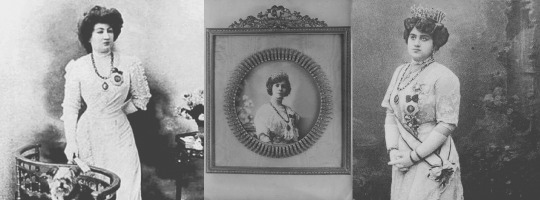

Rukiye Sabiha Sultan on her wedding day in 1921
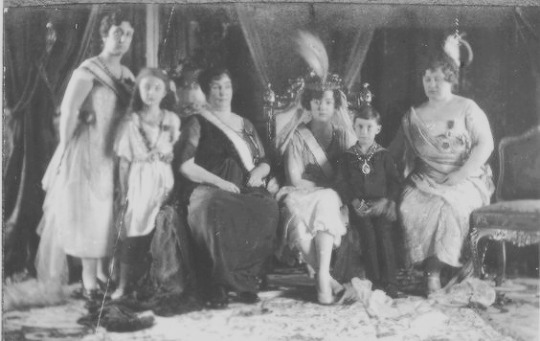
other photo of Rukiye Sabiha Sultan’s wedding
So... yeah, by the fall of the empire clothes were completely European.
#anon#ask post#ask: ottoman history#ottoman fashion#ottoman photos#late ottoman empire#nazima sultan daughter of abdulaziz#naime sultan daughter of abdulhamid ii#saliha sultan daughter of abdulaziz#fatma sultan daughter of abdulmecid i#mediha sultan daughter of abdulmecid i#refia sultan daughter of abdulmecid i#hatice sultan daughter of murad v#fehime sultan daughter of murad v#fatma sultan daughter of murad v#rukiye sabiha sultan daughter of mehmed vi
195 notes
·
View notes
Note
The youngest Ottoman princess to become a mother?
The problem is sometimes we don't have exact dates of births so it is quite difficult to say. Nevertheless, this is what I have found:
Selçuk Sultan, daughter of Bayezid II: her first child, Sultân-zâde Gaazî Husrev Bey/Paşa, seems to have been born when she was fifteen
Fatma Sultan, daughter of Selim II: her first (?) child, Sultân-zâde Ahmed Bey, seems to have been born when she was fifteen
Gevherhan Sultan, daughter of Ahmed I: if we believe 1608 to have been her date of birth, it seems that she had a child at the age of 12. Taking into consideration the whole trend, twelve seems to be a little too early even for a princess.
Hatice Sultan, daughter of Mehmed IV: her first child, Sultân-zâde Mehmed Bey, seems to have been born when she was sixteen.
Fatma Sultan, daughter of Ahmed III: her only (?) child, Sultân-zâde Mehmed Bey, seems to have been born when she was fourteen
Saliha Sultan, daughter of Ahmed III: her first child, Sultân-zâde Ahmed Bey, seems to have been born when she was fourteen
Ayşe Dürrüşehvar Hanım, daughter of Abdülhamid I: her first daughter, Atıyyetullâh Hanım, seems to have been born when she was around fifteen
Fatma Sultan, daughter of Abdülmecid I: her first child, Cemile Hanım-Sultân, was born when she was fifteen.
Mediha Sultan, daughter of Abdülmecid I: her only child, Sultân-zâde 'Abdurrahmân Sâmî Beyefendi, was born when she was fifteen
Without considering Gevherhan Sultan, which seems an anomaly but also could be the result of wrong information, it seems that the earliest that princesses gave birth was at the age of fourteen. Of course, we don’t have all the dates so there could have been earlier births.
#anon#ask post#ask: ottoman history#selcuk sultan daughter of bayezid ii#fatma sultan daughter of selim ii#gevherhan sultan daughter of ahmed i#hatice sultan daughter of mehmed iv#saliha sultan daughter of ahmed iii#fatma sultan daughter of ahmed iii#ayse durrusehvar hanim daughter of abdulhamid i#fatma sultan daughter of abdulmecid i#mediha sultan daughter of abdulmecid i#Anonymous
21 notes
·
View notes
Photo









Mahmud II of the Ottoman Empire + the women in his life
#history#historyedit#ottoman history#mahmud ii#naksidil sultan#cevri kalfa#esma sultan daughter of abdulhamid i#nevfidan kadin#husnumelek hanim#saliha sultan daughter of mahmud ii#bezmialem sultan#pertevniyal sultan#*womeninlife#ottomanladiesedit#he did not have favourite consorts so i went with these
1K notes
·
View notes
Text
On this day, 10 August, in Ottoman history
10 August 1854 - wedding of Fatma Sultan: daughter of Sultan Abdülmecid and Gülcemal Kadınefendi, she married Galib Paşa at Dolmabahçe Palace. With him she had Cemile Hanımsultan, who died in infancy. Galib Paşa died on 15 September 1858.
10 August 1862 - birth of Fatma Saliha Sultan: daughter of Abdülaziz and Senior Imperial Consort Dürrinev, she was Şehzade Yusuf İzzeddin Efendi’s younger sister. At the age of 13, she was betrothed to İbrahim Hilmi Paşa, son of the Khadive of Egypt, but when her father was deposed, Abdülhamid II broke the engagement. On 20 April 1889, she married Ahmed Zülküf Bey (later Paşa). Their only child, Kamile Hanımsultan, died at the age of 6. In 1924, when the Dynasty was expelled from Turkey, she first went to Rome, to Damascus and in the end settled in Cairo. She died in 1941 and was buried there, in the Abbas Hilmi mausoleum.
10 August 1916 - wedding of Fatma Ulviye Sultan: daughter of Mehmed VI Vahideddin and Senior Imperial Consort Nazikeda, she married Ismail Hakkı Okday Bey in Dolmabahçe Palace. On 4 June 1917, their only child, Suade Hümeyra Hanımsultan, was born. The couple would divorce in 1922.
10 August 1960 - death of Hamîde Ayşe Sultan: daughter of Abdülhamid II and Müşfika Kadınefendi, she was born on 2 November 1887 in Yildiz Palace. She is the author of “My father, Sultan Abdülhamid”, which she published under the name Ayşe Osmanoğlu. She married Dâmad Ahmed Nâmî Beyefendi in 1911, and had three children with him: Sultanzade Ömer Nami (1912), Aliyye Hanımsultan (1913), Sultanzade Osman Nami (1918). The couple divorced in 1921 when Ayşe met Lieutenant Colonel Mehmed Ali Bey at a banquet in Dolmabahçe Palace. He was married with children, though, so he first had to divorce his wife before he could marry the princess. His son from his first wife wrote in his memoirs that his mother couldn’t stop crying after the news. Nevertheless, Ayşe Sultan and Mehmed Ali Bey got married on 3 April 1921 in Yildiz Palace. A year later, she gave birth to Sultanzade Abdülhamid Rauf Bey. When the Dynasty was exiled, she moved to France with her family - where Mehmed Ali died in 1937 - until 1952, when she was admitted in Turkey again. She died at the age of 72 and she was buried in the Yahya Efendi Cemetery.
#history#ottoman history#on this day in history#on this day in ottoman history#fatma sultan daughter of abdulmecid i#saliha sultan daughter of abdulaziz#ulviye sultan daughter of mehmed vi#ayse sultan daughter of abdulhamid ii#late ottoman empire
15 notes
·
View notes
Text
Sultân Abdülazîz + family
Consorts:
Dürr-i Nev Başkadınefendi (15.3.1835-4.12.1895): born Princess Melek Dziapş-lpa, she was the daughter of Prince Mahmud Bey Dziapş-lpa and Princess Halime Hanım. She was the eldest of three sisters and entered palace service with her younger sister Princess Ayşe Kemalifer. She became a lady of Servetseza Kadınefendi and received a good education: she was a good pianist and could speak French without an accent. She also made some paintings which she later gave to Bezmialem Valide Sultan and Servetseza Kadınefendi. Dürrinev had long blonde hair and hazel eyes; when the future Sultan Abdülaziz first saw her, he immediately asked Servetseza Kadınefendi to let him marry his lady-in-waiting. The wedding took place on 20 May 1856 in Dolmabahçe Palace; a year later she gave birth to Yûsuf İzzeddîn Efendi (1857-1916), then to Saliha Sultan (1862-1941). After Abdülaziz's dethronement, she was imprisoned in Feriye Palace in the apartments above his. She fainted when she saw his corpse. She died on 4 December 1895 and was buried in the mausoleum of Mahmud II.
Edâ-dil Kadınefendi (1845?-1875): Second Imperial Consort, she was Abkhazian and was the daughter of Prince Aredba Tandal Bey. She entered palace service at a young age, where she was especially liked by Pertevniyal Valide Sultan. Edadil was given to Sultan Abdülaziz as a gift for his accession to the throne. She was said to be beautiful, with blue eyes and brown hair. She was the mother of Mahmûd Celâleddîn Efendi (1862-1888) and Emine Sultan (1866-1867). The sudden death of her brother affected her a lot and she died young in 1875. She was buried in the mausoleum of Mahmud II.
Hayrân-ı Dil Kadınefendi (1846-1895): Second Imperial Consort after the death of Edâ-dil Kadınefendi. There is no certain information about her background and family, nor how she entered palace service before becoming a consort. She married Sultan Abdülaziz on 21 September 1865, a year later she gave birth to Nazime Sultan (1866-1895/1947) and then to Caliph Abdülmecid II (1868-1944). After the deposition of Murad V, she was allowed to retire to Ortaköy Palace. She died on 26 November 1895 and was buried in the mausoleum of Mahmud II.
Neşerek Kadınefendi (1848-1876): Third Imperial Consort, she was most probably Caucasian and born in Sochi to Prince İsmail Bey Zevş-Barakay. She married Sultan Abdülaziz in 1868. She was the mother of Mehmed Şevket Efendi (1872-1899) and of Emine Sultan (1874-1920). She died on 11 June 1876 and was buried in the Yeni Mosque.
Gevheri Kadınefendi (1856-1884): Fourth Imperial Consort, she was the mother of Esma Sultan (1873-1899) and Mehmed Seyfeddin Efendi (1874-1927). Her real name was Enime, her father was Salih Bey and her mother was the daughter of Prince Tsanba Osman Bey. She had long curly auburn hair and blue eyes. She always wore white dresses and a light blue veil on her head; her only jewelry were the rings Abdülaziz gave her on their wedding day in 1872. Gevheri was a very charitable women: she helped the poor however she could, paid for the education of young orphans and even supplied funds to repair several mosques and schools. She died in Ortaköy Palace on 6 September 1884 and was buried in the Yeni Mosque.
Children
Şehzade Yûsuf İzzeddîn Efendi (11.10.1857-1.2.1916): Abdülazîz's eldest child, he was kept secret in Kadri Bey's villa in Eyüp until his accession to the throne in 1861. He was considered the true heir to the throne by his father, who tried throughout his reign to change the line of succession to primogeniture. Izzeddin travelled to Europe with his father at 10 years old and later, in 1910, represented the Ottoman Dynasty at the funeral of Edward VII of the United Kingdom. He had five consorts and four children: Șehzade Mehmed Bahaeddin (2.1883 - 8.11.1883), Hatice Şükriye Sultan (24.2.1906 - 1.4.1972), Șehzade Mehmed Nizameddin (18.12.1908-19.3.1933) and Mihriban Mihrişah Sultan (30.8.1916 -25.1.1987)
Saliha Sultan (10.8.1862-1941): Şehzade Izzeddin's full-sister. She was born in Dolmabahçe Palace. At the age of 13, she was engaged to the son of the Khedive of Egypt, but Abdulhamid II broke the engagement, and Saliha Sultan had to wait 13 more years before getting married. In 1889 she married Ahmed Zülküf Bey (later Paşa), who was said to have been very handsome. Their only child was Kâmile Hanım-Sultân (1890-1896). She moved to Egypt after the Dynasty was exiled and died in poverty at the age of eighty.
Şehzade Mahmud Celaleddin Efendi (14.11.1862-1.9.1888): he was Vice Admiral of the Imperial Army, a pianist and a flautist. His aunt Adile Sultan, a renowned poet, wrote several compositions to celebrate him.
Nazima Sultan (25.2.1866-1895/1947): daughter of Second Imperial Consort Hayrân-ı Dil Kadınefendi, she studied French in childhood. She married Dâmâd Alî Hâlid Paşâ on 20 April 1889. While Öztuna claims that she died in 1947, Sakaoğlu believes that his source, N. S. Örik, mistook Nazima for her elder sister Saliha.
Şehzade Mehmed Selim Efendi (28.10.1866-21.10.1867): buried in the mausoleum of Mahmud II
Emine Sultan (30.11.1866-23.1.1867): buried in the mausoleum of Mahmud II
Caliph Abdülmecid II (29.5.1868-23.8.1944): younger child of Second Imperial Consort Hayrân-ı Dil Kadınefendi, he was the last Caliph of the Ottoman Empire.
Şehzade Mehmed Şevket Efendi (5.6.1872-22.10.1899): son of Third Imperial Consort Neşerek Kadınefendi, he was only 4 years old when he lost his father so he grew very close to his uncle Abdülhamîd II, who took him to Yildiz Palace and raised him alongside his sons. He was married to Fatma Rûy-i Nâz Hanımefendi and had a son, Mehmed Cemâleddîn Efendi (1891-1947).
Esma Sultan (21.3.1873-7.5.1899): daughter of Fourth Imperial Consort Gevheri Kadınefendi, according to Alderson she was instead daughter of Neşerek Kadınefendi. As she had lost her father at the age of three, she grew up in the household of her eldest brother Şehzade Yûsuf İzzeddîn Efendi. She was very beautiful: tall, slim, with black eyes and very white skin. On 20 April 1889 she married Dâmâd Kabasakal Çerkes Mehmed Paşa, 20 years her senior and previously the husband of her aunt Naile Sultan. She had five children: Sultân-zâde Hasan Bedreddîn Beyefendi (1890-29.1.1909), Sultân-zâde Hayreddîn Beyefendi (1892-1987), Mihribân Hanım-Sultân (1894-1894), Sultân-zâde Sâ'deddîn Beyefendi (14.6.1895-1970s) and Sultân-zâde 'Abdullâh Beyefendi (1899-stillborn). Esma Sultan died after delivering her fourth son and fifth child.
Fatma Sultan (1874-1875): buried in the mausoleum of Mahmud II
Emine Sultan (24.8.1874-29.1.1920): daughter of Neşerek Kadınefendi, she was raised in the household of her eldest brother Şehzade Yûsuf İzzeddîn Efendi. She married Dâmâd Mehmed Şerif "Çavdaroğlu" Paşa in 1901 and had a daughter with him, Hamide Hanım-Sultân, who died in infancy.
Şehzade Mehmed Seyfeddîn Efendi (22.9.1874-19.10.1927): Vice Admiral of the Ottoman army, he was a great musician, a student of Callisto Guatelli. In 1914 he bought the organ from the Chapelle St. Louis and had it brought to Istanbul. He had two consorts and four children: Şehzade Mehmed Abdülazîz Efendi (1901-1977), Şehzade Mahmud Sevket Efendi (1903-1973), Şehzade Ahmed Tevhid Efendi (1904-1966) and Fatma Gevheri Sultan (1904-1980)
Münire Sultan (1877): posthumous child, she died in infancy.
#history#ottoman history#Abdulaziz#*consortsandchildren#durrinev kadin#edadil kadin#hayranidil kadin#neserek kadin#gevheri kadin#sehzade yusuf izzeddin son of abdulaziz#saliha sultan daughter of abdulaziz#nazima sultan daughter of abdulaziz#esma sultan daughter of abdulaziz#emine sultan daughter of abdulaziz#sehzade mahmud celaleddin son of abdulaziz#abdulmecid ii#sehzade mehmed sevket son of abdulaziz#sehzade mehmed seyfeddin son of abdulaziz
18 notes
·
View notes
Note
Can you list some information about Abdulmecid I’s children with some information about them just like you did for Ahmed III harem + children.
Sorry for the long wait but... the guy had 42 children
Mevhibe Sultan (1840-1841), with Hoşyar Kadın: lived for only 8 months, was buried in the Hamidiye Mausoleum
Sultan V. Murad Han (1840-1904), with Şevkefza Valide Sultan: 33rd Ottoman sultan, he reigned for only 93 days, after which he was deposed on the grounds of "perpetual insanity"
Naime Sultan (1840-1843), with Tirimüjgan Kadın: Abdülhamid II's elder sister, she died of smallpox
Fatma Sultan (1840-1884), with Gülcemal Kadın: Mehmed V's eldest sister and Murad V's favourite sister. She had two husbands: Dâmâd'Alî Gaalib Paşa and Dâmâd Mehmed Nûrî Paşa, which she outlived. Her three children died in infancy and she spent the last years of her life confined in her villa in Istanbul because she had tried to reinstate Murad V on the throne. She died at the age of 44 and was buried in Murad V's mausoleum.
Behiye Sultan (1841-1847), mother unknown: she died at the age of 6 and was buried in the mausoleum of Refia Sultan. Her mother was "Her Highness, the Second Ikbal"
Neyyire Sultan (1841-1843), with Şayeste Hanım: she died at the age of 3 and was buried in the Nurosmaniye Mosque.
Refia Sultan (1842-1880), with Gülcemal Kadın: Mehmed V's elder sister. She was married to Dâmâd Mahmûd Edham Paşâ and had a daughter with him. Refia was extremely educated, like her sisters, as her father had insisted for them to be educated both in traditional and western subjects. Contrary to her younger sister Cemile, whom her father constantly lauded, Refia was a true spendthrift and her debts were staggering for just one person.
Hatice Sultan (1842-1842), with Gülcemal Kadın
Sultan II. Abdülhamid Han (1842-1918), with Tirimüjgan Kadın: 34th Ottoman Sultan, he was deposed by the Young Turks in 1909 and exiled to Thessalonika. None of his sons would ascend the throne.
Aliye Sultan (1842-1845), with Şevkefza Valide Sultan: younger sister of Murad V, she was 2 when she died and was buried in the New Mosque
Mehmed Ziyaeddin Efendi (1842-1845), with Nesrin Hanım:
Cemile Sultan (1843-1915), with Düzdidil Hanım: her mother died when she was 3, so she was raised by Rahime Perestu, future Valide Sultan. She was therefore very close to her older brother Abdülhamid II, who had been raised by Rahime Perestu as well. She married Dâmâd Mahmûd Celaleddîn Paşa in 1858, when she was fifteen. Her husband was the second son of Dâmâd Ahmed Fethî Paşa (husband of Mahmud II's daughter, Atiye Sultan) from his first wife. Fındıklı Palace was built for them. Together they had 6 children: Fethiye Hanım-Sultân (1859 - 1887), Sultân-zâde Besim Beyefendi (died at the age of 2), Sultân-zâde Sâkıb Beyefendi (1864 - 1897), Sultân-zâde Mehmed Mahmûd Celâleddîn Beyefendi (1864 - 1916), 'Ayşe Şıdıka Hanım-Sultân (1875 - 1937?), Fatma Hanım-Sultân (1879 - 1890)
Sultan V. Mehmed Reşad Han (1844-1918), with Gülcemal Kadın: 35th Ottoman Sultan, he was enthroned by the Young Turks after the deposition of Abdülhamid II and was the last sultan to die in office.
Münire Sultan (1844-1862), with Verdicenan Kadın: she firstly married the son of the Egyptian Khedive, İbrahim İlhami Paşa, and the costly wedding ceremony attracted a lot of criticism because the Imperial Army had just been defeated in Montenegro. The marriage lasted only two years, as İbrahim İlhami Paşa died at only 24 years old. She therefore married Lieutenant General Dâmâd İbrahim Paşa, with whom she had a son: Sultân-zâde 'Alâeddîn Beyefendi (1861 - 1915?). She was buried in the mausoleum of her great-grandmother, Nakşıdil Valide Sultan.
Samiye Sultan (1845-1845), mother unknown: she was buried in the New Mosque. Her mother had been listed as "Her Highness, the Third Kadinefendi"
Ahmed Efendi (1846-1846), with Nükhetseza Hanım: he was buried in the New Mosque inside the mausoleum of Refia Sultan
Fatma Nazime Sultan (1847-1847), mother unknown: she was buried in the mausoleum of Refia Sultan
Sabiha Sultan (1848-1849), with Mehtab Kadın: she was buried in the mausoleum of Refia Sultan
Mehmed Abid Efendi (1848-1848), with Tirimüjgan Kadın: he was buried in the mausoleum of Refia Sultan
Ahmed Kemaleddin Efendi (1848-1905), with Verdicenan Kadın: he was a supporter of Murad V's rights to the throne and was in a bad relationship with her other older brother, Abdulhamid II. He married his only consort, Fatma Sezâ-dil Hanımefendi, in 1876, and had two daughters with her: Atiyetullah Sultan (1878-1878) and Münire Sultan (1880-1939). His daughter married Dâmâd Mehmed Sâlih Paşa in 1907 and had a son, Sultân-zâde Ahmed Kemâleddîn (Keredin) Beyefendi (1908-1987), clearly named after her father.
Atiyetullah Efendi (?-?)
Mehmed Fuad Efendi (died in infancy), with Nergizu Hanım: he was buried in the mausoleum of Refia Sultan
Behice Sultan (1848-1876), with Nesrin Hanım: she lost her mother at the age of 3 and contracted tuberculosis in childhood. She lived secluded all her life and her sisters Refia and Seniha always sent her letters to cheer her up, even though they knew that Behice's illness had reached the final stage by the time she had turned 20. In her letters, Behice came across as frustrated, jealous of her sisters' freedom and extremely sensitive. Her dowry had been prepared by her father but her illness always prevented her from getting married, even though that was her dream. Finally, her uncle Abdülaziz consented, and Behice married Dâmâd Halil Hamîd Beyefendi on 16 November 1876. Unfortunately, the princess died just 20 days later at the age of 28. She was buried in the mausoleum of Münire Sultan.
Mehmed Burhaneddin Efendi (1849-1876), with Nükhetseza Hanım: he was Abdülhamîd II's favourite brother, who also named a warship after him. He had two consorts: Mest-i Niyâz Hanımefendi and Şâd-rûy Hanımefendi. From his first consort, he had an unnamed daughter (1876? -1890?) and Ibrahim Tevfik Efendi (1874-1931). He was buried in the mausoleum of his father Abdülmecid
Rukiye Sultan (1850-1850), with Gülcemal Kadın:
Mukbile Sultan (1850-1850), mother unknown: buried in the mausoleum of Refia Sultan, her mother had been listed as "Her Highness, the Fourth Ikbal"
Mehmed Vamık Efendi (1850-1850), mother unknown: buried in the mausoleum of Refia Sultan
Nizameddin Efendi (1850-1853), with Nesrin Hanım: twin of Bahaeddin Efendi, he was buried in the mausoleum of Murad V
Bahaeddin Efendi (1850-1852), with Nesrin Hanım: twin of Nizameddin Efendi, he was buried in the mausoleum of Refia Sultan
Ahmed Nureddin Efendi (1852-1885), with Mehtab Kadın: he had two consorts, Nazlı Emşâl Hanımefendi and an unnamed one, but no children. He died at the age of 33 and was buried in the mausoleum of Murad V
Mehmed Rüşdü Efendi (1852-1852), with Ceylanyar Hanım: buried in the Hamidiye Tomb.
Osman Safiyeddin Efendi (1852-1855), with Ayşe Serfiraz Hanım: buried in the mausoleum of Abdülmecid I
Seniha Sultan (1853-1931), with Nalandil Hanım: she married Dâmâd Âsaf Mahmûd Celaleddîn Paşa (the son of Dâmâd Halil Rifat Paşa after the death of Saliha Sultan, daughter of Mahmud II) in 1877. Celaleddîn Paşa wasn't particularly trusted by Abdülhamid II but was nevertheless appointed vizier. Seniha and her husband participated in the Ali Suavi Incident, actually a conspiracy to dethrone Abdulhamid II and re-instate Murad V, the failure of which - among other things - prompted Celaleddîn Paşa to leave the Ottoman empire and settle in Bruxelles. Together, they had two sons: Sultân-zâde Mehmed Sabâhaddîn Beyefendi (1877-1948) and Sultân-zâde Ahmed Lutfullâh Beyfendi (1880-1973). Her son Sabâhaddîn was a vocal critic of Abdülhamid II's regime and was actually the leader of a faction inside the Young Turks movement which advocated some of the same liberal principles of the CUP but instead favoured administrative decentralization and European assistance. At the time of the Dynasty's exile from Turkey, Seniha Sultan was the eldest princess alive. She lived with Mehmed VI in Sanremo until his death, then moved to Nice, where the last Caliph Abdülmecid II had settled down but was not in favour because she was part of the "Mecid branch" of the family. She spent her last years bedridden in a room inside the caliph's villa and Nice and died there in 1931. She was buried in the Sultan Selim Mosque in Damascus.
Abdullah Efendi (1853-1853), with Şayeste Hanım: stillborn
Mehmed Abdüssamed Efendi (1853-1855), with Nalandil Hanım: buried in the mausoleum of his father
Zekiye Sultan (1855-1856), with Gülistu Kadın: twin of Fehime Sultan, was buried in the mausoleum of Münîre Sultân
Fehime Sultan (1855-1856), with Gülistu Kadın: twin of Fehime Sultan, was buried in the mausoleum of Münîre Sultân
Mediha Sultan (1856-1928), with Gülistu Kadın: elder sister of Mehmed VI, she fell in love with the son of Sâmi Paşa and started corresponding with him. When Abdülhamid II found out, he sent Necib Bey at the embassy in Paris. Mediha was devastated: she would not drink, eat or sleep. Her step-mother Verdicenan asked Rahime Perestu Valide Sultan's help, and together they were able to convince Abdülhamid to let the princess marry Necib Bey, which she did in 1879. Mediha had a son with him, Sultân-zâde 'Abdurrahmân Sâmî Beyefendi (1880-1961), but her happiness was short-lived: her husband died in 1885 at the age of 29. In 1886, she married her second husband, Dâmâd Mehmed Ferîd Paşa, but had no children with him.
Naile Sultan (1856-1882), with Şayeste Hanım: she married Dâmâd Çerkes Kabasakâl Mehmed Paşa who, according to Ayşe Osmanoğlu, was a brother of Abdülhamid II's consort Bidar Kadın. They had no children. She was buried in the mausoleum of Murad V
Bedia Sultan (1857-1858), with Ayşe Serfiraz Hanım: she was buried in the mausoleum of Münîre Sultân.
Selim Süleyman Efendi (1860-1909), with Ayşe Serfiraz Hanım: he had 5 consorts: Filiz-san Hanımefendi, Emîne Câvidân Hanımefendi, Fatma ikbâl Hanımefendi, 'Ayşe Tarz-ı ter (Tarz-ender) Hanımefendi and Zât-ı Melek Hanımefendi. His children were: Mehmed 'Abdülhalîm Efendi (1894-1926), Emine Naciye Sultan (1896-1961), and Damad Mehmed Şerefeddin Efendi (1904-1966)
Sultan VI. Mehmed Vahideddin Han (1861-1926), with Gülistu Kadın: last sultan of the Ottoman Empire, he was deposed in 1922 when the Republic of Turkey was proclaimed and exiled in 1924. He died in Sanremo, Italy
#anon#ask post#ask: ottoman history#abdulmecid i#murad v#abdulhamid ii#mehmed v#mehmed vi#fatma sultan daughter of abdulmecid i#refia sultan daughter of abdulmecid i#cemile sultan daughter of abdulmecid i#munire sultan daughter of abdulmecid i#sehzade ahmed kemaleddin son of abdulmecid i#behice sultan daughter of abdulmecid i#sehzade mehmed burhaneddin son of abdulmecid i#seniha sultan daughter of abdulmecid i#mediha sultan daughter of abdulmecid i#naile sultan daughter of abdulmecid i#sehzade selim suleyman son of abdulmecid i
21 notes
·
View notes